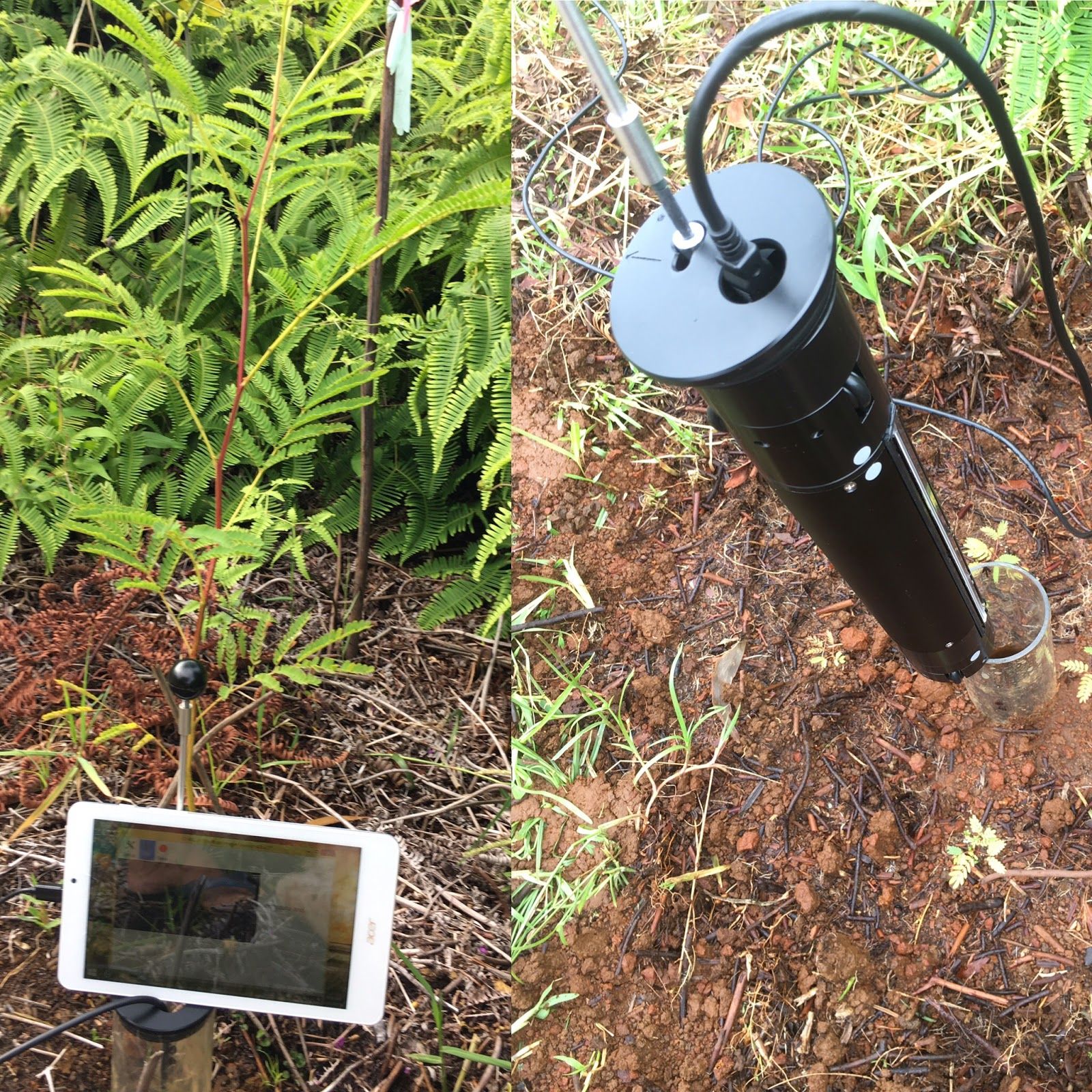November 16, 2016 at 7:05 am | Updated April 20, 2022 at 1:52 pm | 3 min read
Mihaela Ryer and her son, Michael Ryer, are using a CI-600 In-Situ Root Imager (our minirhizotron system) and CI-340 Handheld Photosynthesis System to monitor the health of Koa Trees—key plants in their restoration efforts.
Native Forest Restoration and Monitoring
Project Report #4
November 3rd, 2016
by Mihaela Ryer and Michael Ryer
October is known as Ikua in the Hawaiian calendar. It’s the month when, according to the Hawaiian folklore, dark storms arise, sea roars, thunder roars, birds roar. We haven’t heard any roaring birds, but certainly had our share of dark storms, thunder and roaring seas. October also makes the transition to the rainy season in Hawaii, and rain we had. But on the east side of the Big Island, rain is part of our identity. It keeps all those shades of green vibrant and brings many beautiful of rainbows (Fig.1).

Subscribe to the CID Bio-Science Weekly article series.
By submitting this form, you are consenting to receive marketing emails from: . You can revoke your consent to receive emails at any time by using the SafeUnsubscribe® link, found at the bottom of every email. Emails are serviced by Constant Contact
Figure 1. Koa trees after an October rainstorm, with a rainbow in the background.
Our reforestation project continued with clearing the invasive Strawberry Guava and replacing it with native Koa, Ohi’a, Pukiawe and A’ali’i (Fig.2). After four-months use of our instruments, we are not only learning how to better deploy our stations and make more accurate measurements, but we are starting to get some preliminary results, which are helping us to make better choices in our reforestation effort.

Figure 2. Six-month old Koa in the foreground and a 50+year old dead Koa in the background. The old Koa, which was overwhelmed and killed by the invasive Strawberry Guava, is now proving to be a good seed bank and a great host for beautiful wild orchids. Our reforestation project is centered around eradicating the invasive species, like the Guava, and replacing them with the native vegetation.
Our activities during the month of October are summarized below:
● Participated in the one-day symposium “Acacia Koa in Hawai’i: Facing the Future”, hosted by the University of Hawai’i, Hilo. Oral presentations were grouped in four topics: Commercial Forestry, Silviculture, Tree Improvement, Ecology and ecophysiology. Besides learning from the presenters and connecting with scientists and experts, we participate with the poster “Native forest restoration on privately-owned land using a science based approach,” which described our work and the instruments we are using.
● In parallel with using the CI-340 Handheld Photosynthesis System on the property, this month we took the instrument and acquired measurements on Koa and Ohi’a trees in other locations on the Big Island. Our new location for the month of October was Kipula Pualulu, in the Hawaii Volcanoes National Park (Figures 3 and 4). This site is located at a higher altitude (~1200m) compared to our property, and it has a lower annual rainfall. By doing these measurements we are attempting to understand if there are any differences in the rate of photosynthesis between the two locations, and if so, what controls these differences. We think these observations will be useful since we are starting to use on our property seeds from other locations on the island, in an effort to increase the Koa and Ohi’a specimen diversity.
● After using the CI-600 Root Imager for the last four months we are learning that we may increase our planting survival rate by placing seeds directly in previously prepared planting sites, as opposed to the commonly used method of using seedlings started in pots. Our measurements (Fig. 5) show that the Koa tree root system takes a significant period of time to re-adapt to its environment after it was transplanted from the pot to the planting site, and as a result the tree development is delayed. To test this hypothesis, over the next year we will monitor, compare and contrast the development of root systems of transplanted seedlings with those of seeds started directly in the ground.

Figure 3. Photosynthesis measurement with the CI-340 Handheld Photosynthesis System on a Koa phyllode, in Kipuka Pualulu, Volcanoes National Park, Big Island of Hawai’i.

Figure 4. Photosynthesis measurement with the CI-340 Handheld Photosynthesis System, on an Ohi’a leaf, in Kipuka Pualulu, Volcanoes National Park, Big Island of Hawai’i.

Figure 5. Acquiring images of Koa root system with the CI-600 In-Situ Root Imager.
Related Products
Most Popular Articles
- Transpiration in Plants: Its Importance and Applications
- Leaf Area – How & Why Measuring Leaf Area…
- How to Analyze Photosynthesis in Plants: Methods and Tools
- Plant Respiration: Its Importance and Applications
- The Forest Canopy: Structure, Roles & Measurement
- Stomatal Conductance: Functions, Measurement, and…
- Forest & Plant Canopy Analysis – Tools…
- Root Respiration: Importance and Applications
- The Importance of Leaf Area Index (LAI) in…
- Irrigating with Saline or Seawater






